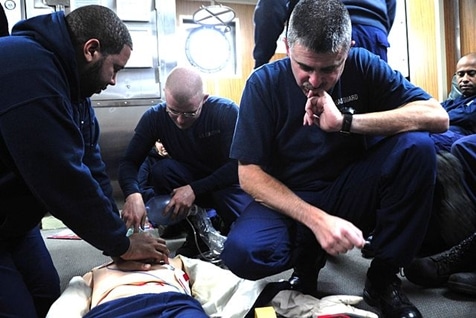Safety in the workplace is a major priority – and rightly so. OH&S regulations make it necessary for equipment and supplies to be available on-site, and through Alsco, complying with these life-saving regulations is easy.
There has been great progress made in recent years to reduce the rate of accident and injury at work, but the threat will never be removed completely.
In 2009-2010, for example, there were a total of 640,700 cases of work-related injury or illness, whether minor or major, with a rate of 53 employees per 1,000 suffering injuries specifically (down from 64 in 2005-2006).
Of course, the particular industry is telling too. Recent figures show the hospitality sector is one of the least safe sectors, with 84 employees in every 1,000 suffering some form of accident.
The arts and recreational services see 77, and the warehousing and transport industries show a rate of 74.
Two Solutions To Save Lives
So, what can be done? How can the very best protection be provided? Well, the solution comes down to two simple factors: Readiness and Knowledge.
Knowledge
Knowledge simply translates to training, or having staff members that know how to deal with any of the variety of accidents and emergencies that might occur on-site. Having staff on the spot who can react properly to an accident can help to save lives.
But treatment techniques and technology are improving all the time, which is why annual re-training sessions for experienced staff are as important as initial first aid courses for new staff members.
Readiness
Readiness requires some investment, with a range of health products and equipment designed specifically for the office or workplace.
We’ve shortlisted three of the most important:
1. First Aid Kits – The basic health and safety object anywhere, whether in an office or a garage shop floor, in a school or even in a public transport vehicle.
Everything necessary is included in the kit when it is bought, but as a few cuts and bruises are attended to over the months, the need to restock increases, making appointing someone responsible for managing the kit important. Often renting a kit bypasses this issue, with stock control and kit monitoring part of a professional first aid kit rental service.
Of course, kit compliance is important, with different states having different requirements. For example, while South Australia confirms that a medium sized first aid kit can cover up to 30 employees, New South Wales believes it is enough to handle no more than 25.
2. External Defibrillators – Increasingly, defibrillators have become as much a part of proper workplace health and safety, as the first aid kits we are so familiar with.
Unfortunately, cardiac problems can be suffered by practically anyone, regardless of age and occupation. It has been estimated that, each year, more than 6% of all Australians over the age of 15 suffer strokes and heart attacks. With the average ambulance response time greater than 10 minutes, the need for on-site treatment in the case of a heart attack is essential.
Thankfully, modern external defibrillators are easy to use, even for a first-timer.
3. Eyewash Station – Only in relatively recent years has the eyewash station become a common sight for workers. But it is designed for more than just getting a loose eyelash or speck of dust out.
Some workplaces, especially on manufacturing floors, in garages, labs and workshops, have debris, liquids and chemicals that can cause serious damage to the eye. The eyewash station provides a safe way to wash out any hazardous substances that, when left in long enough, might cause irreparable damage.
Things Are Improving Every Year
Figures from Safe Work Australia, relating to the 2008-2009 fiscal year, show reductions in accidents and fatalities in every employment sector. The construction industry saw a fall of 24% from figures in 2003, with the manufacturing, storage and transport industries all seeing a fall of 21%.
In terms of work fatalities, Australia recorded the seventh lowest rate of work-related injury fatalities in the world in the two years between 2006 and 2008.
And while general education and safety measures have played a big part in these improvements, there is no doubt too that having access to live-saving equipment, like external defibrillators, sight-saving eye wash stations, and properly stocked and managed first aid kits, has had a significant influence too.
Since safety comes first, our friendly representatives are always here to help. Don’t delay, contact Alsco for detailed information.
Sources:
- ‘Work and Health’ (2011), The Australian Bureau of Statistics – www.abs.gov.au/AUSSTATS/abs@.nsf/Lookup/4102.0Main+Features20Jun+2011
- ‘National OHS Strategy 2002-2012’, Safe Work Australia – www.safeworkaustralia.gov.au/AboutSafeWorkAustralia/WhatWeDo/Publications/Documents/230/NationalOHSStrategy_2002-2012.pdf
Image courtesy: Geo Swan


LEAVE A REPLY
Your email address will not be published. Required fields are marked *
You must be logged in to post a comment.